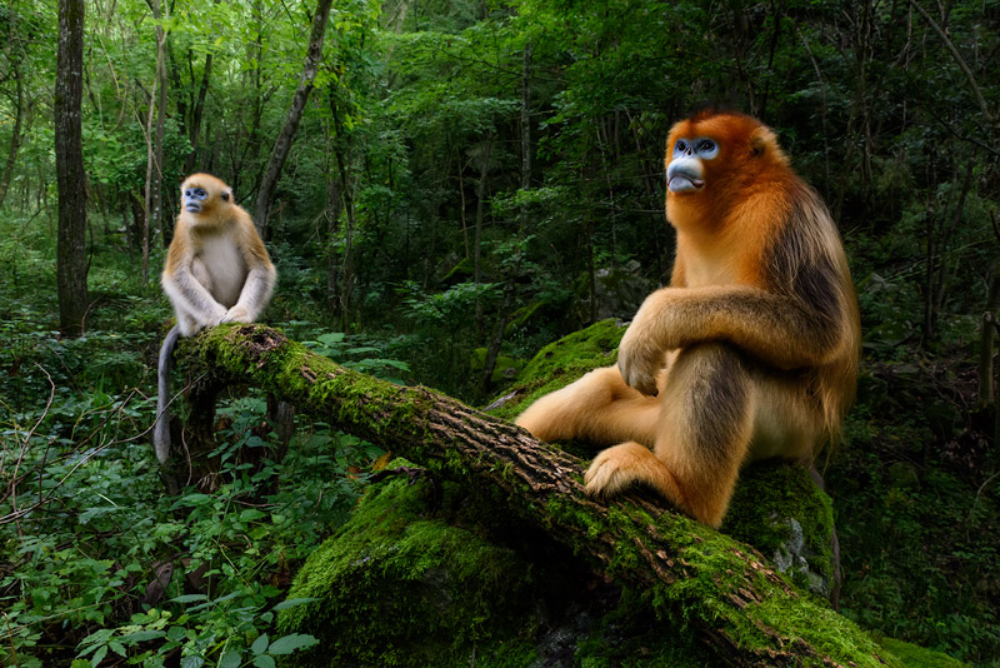Nestled in the mist-shrouded forests of central and southwestern China, amidst the towering peaks of the Qinling and Minshan Mountains, roams a creature of exquisite beauty and mystique – the Golden Snub-nosed Monkey (Rhinopithecus roxellana). Revered for its striking appearance and unique adaptations, this primate species stands as a testament to the enchanting diversity of life on Earth. Yet, like many of its fellow inhabitants of China’s biodiverse-rich landscapes, the golden snub-nosed monkey faces numerous threats to its existence, underscoring the urgent need for conservation efforts to safeguard its future.
A Glimpse into the Golden Realm
The Golden Snub-nosed Monkey is an Old World monkey belonging to the Colobinae subfamily. They are renowned for its golden fur, contrasting with dark skin and striking blue faces. These monkeys possess a distinctive appearance that sets them apart from their primate relatives. Their upturned, almost “snub” nose adds an endearing charm to their visage, lending them their name.
These arboreal primates inhabit high-altitude forests, ranging from 1,500 to 4,500 meters above sea level, where they navigate the dense foliage with agility and grace. Their diet primarily consists of lichens, supplemented by leaves, fruits, and seeds. Living in large, multi-male, multi-female social groups, golden snub-nosed monkeys exhibit complex social behaviors, including grooming rituals, vocalizations, and hierarchical structures.
Conservation Status and Threats
Despite their captivating allure, the golden snub-nosed monkeys face a precarious future. They are classified as Endangered by the International Union for Conservation of Nature (IUCN). These monkeys confront a suite of threats that imperil their survival.
Habitat Loss and Fragmentation
One of the most significant challenges confronting golden snub-nosed monkeys is habitat loss and fragmentation. Rapid urbanization, agricultural expansion, and infrastructure development encroach upon their forest homes, reducing available habitat and fragmenting populations. As forests are cleared for timber and conversion to agricultural land, these monkeys are left isolated in diminishing pockets of suitable habitat, making them more vulnerable to extinction.
Climate Change
The impacts of climate change further exacerbate the challenges faced by golden snub-nosed monkeys. Shifts in temperature and precipitation patterns can alter the distribution of vegetation, affecting the availability of food resources. Additionally, extreme weather events such as droughts and storms can disrupt feeding behaviors and breeding patterns, leading to population declines.
Hunting and Poaching
Golden snub-nosed monkeys are also targeted by hunters for their fur, meat, and perceived medicinal value. Despite legal protections, illegal hunting and poaching persist in some regions, driven by demand for traditional Chinese medicine and bushmeat. This exploitation poses a direct threat to monkey populations, particularly in areas with limited enforcement of conservation laws.
Protected Areas and Habitat Restoration
Efforts to conserve the golden snub-nosed monkey are underway, led by government agencies, non-profit organizations, and local communities. Establishing protected areas and nature reserves is crucial for safeguarding the remaining habitat of golden snub-nosed monkeys. These protected areas provide sanctuary for the monkeys and other wildlife, prohibiting destructive activities such as logging and hunting. Additionally, habitat restoration initiatives aim to reforest degraded landscapes, creating contiguous habitats and corridors to facilitate the movement of monkey populations.
Community Engagement and Education
Engaging local communities in conservation initiatives is essential for the long-term success of golden snub-nosed monkey conservation. Education and outreach programs raise awareness about the importance of protecting these monkeys and their habitats. Providing alternative livelihood opportunities, such as ecotourism and sustainable resource management, can reduce reliance on activities that harm monkey populations.
Research and Monitoring
Ongoing scientific research is critical for understanding the ecology and behavior of golden snub-nosed monkeys and monitoring population trends. Researchers study habitat use, feeding habits, and social dynamics to inform conservation strategies. Monitoring programs track population size, reproductive success, and genetic diversity, providing valuable data for assessing the effectiveness of conservation efforts and identifying areas for intervention.
 Conclusion
Conclusion
The golden snub-nosed monkey stands as a symbol of China’s natural heritage. They are a living testament to the country’s rich biodiversity and cultural legacy. Yet, without concerted conservation action, this iconic species faces an uncertain future.
Protecting the golden snub-nosed monkey requires collaborative efforts at local, national, and international levels. By preserving their forest habitats, combating illegal hunting and poaching, and engaging local communities in conservation initiatives, we can ensure that these majestic primates continue to roam the mist-clad mountains of China for generations to come.
As stewards of the Earth, it is our responsibility to safeguard the golden snub-nosed monkey and all of its fellow inhabitants of China’s forests. Only through collective action and unwavering dedication can we ensure a brighter, more sustainable future for these magnificent creatures and the ecosystems they call home.









